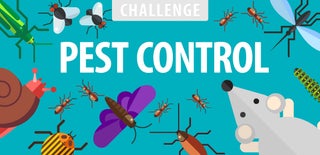Introduction: Anti-Mosquito Machine
Hi,in this tutorial I am going to show you how to make an electronic mosquito repeller and swatter controlled by arduino. Whenever you sit near your desk no one would like to hear popping sounds of swatter but a repeller there would work well and if you are far away then swatter must be on. Some insects, such as grasshoppers and locusts, can detect frequencies from 50,000 Hz to 100,000 Hz, and lacewings and moths can detect ultrasound as high as 240,000 Hz produced by insect-hunting bats. Contrary to popular belief, birds cannot hear ultrasonic sound. Some smartphone applications attempt to use this technology to produce high frequency sounds to repel mosquitoes and other insects.
Step 1: Things Required
You need :-
- High voltage circuit from old mosquito swatter racket
- net made of conductive material
- UV Pen
- 555 timer
- 1 k resistor
- Arduino
- Relay
- Aluminium Foil
- Jumper Wires
etc.
Step 2: Making Repeller and Choices
The concepts of these mosquito repellers are simple and we can build a simple mosquito repellent circuit at home easily by using 555 timer IC and few other commonly available components. So here we are going to design a simple mosquito repellent circuit which will be producing a sound of approximately 40 kHz.You can either generate the frequency near to 40 khz using tone() function or by making a circuit using 555 timer and few other components.
Step 3: The Circuit
Please see here to see the schematics of the circuit and detail how it works basically mosquitoes and some other pests are afraid of some frequencies like us,when we hear very high pitch sound it becomes intolerable for us to bear that sound.Same is here in case of mosquitoes.
Step 4: Swatter Circuit
The grid of the flyswatter is electrically charged to a voltage of between 500 and 1500 V DC, activated by pressing and holding a button. When the electrically conductive body of a fly nearly bridges the gap between electrodes, a spark jumps through the fly. A capacitor attached to the electrodes discharges during the spark, and this initial discharge usually stuns or kills the fly. If the button is still pressed, the continuous current will roast and kill the fly. Many flyswatters have a three layer grid to prevent people from touching both electrodes. The outermost grids or rods are at the same electrical potential, and are open enough to allow an insect to contact the inner charged grid.We will use the broader net for this work!! And the relay controls its switch
Step 5: Uv Pen
Unlike humans, some species of flying insect such as houseflies and bluebottles, wasps and mosquitoes can see ultraviolet light. In the 365-nanometre range in particular it exerts an enormous attraction on these bugs. This fact has been put to use for almost 20 years in the indoor battle against injurious flying insects. We can get that UV-A from the pens with invisible ink.
Step 6: Using Relay
We soldered two wires from the HV circuit to make a switch controlled using relay.
Step 7: Modifying
The red indicator L.E.D would be replaced by UV L.E.D and hence attract insects whenever the swatter mode get turned on.
Step 8: Wrapping Up
Wrap up everything by packing everything in a box with all settings according to your needs.
Step 9: Code
Upload this code and connect the things mentioned in it according to the define statements :-
#define echoPin 12
#define Buzzer 11 #define led 10 #define relay 9 #define led2 8
void setup() { Serial.begin (9600); pinMode(trigPin, OUTPUT); pinMode(echoPin, INPUT); pinMode(Buzzer, OUTPUT); pinMode(led, OUTPUT); pinMode(relay, OUTPUT); pinMode(led2, OUTPUT); }
void loop() { long duration, distance; digitalWrite(trigPin, LOW); // Added this line delayMicroseconds(2); // Added this line digitalWrite(trigPin, HIGH); // delayMicroseconds(1000); - Removed this line delayMicroseconds(10); // Added this line digitalWrite(trigPin, LOW); duration = pulseIn(echoPin, HIGH); distance = (duration/2) / 29.1; if (distance < 40) { // This is where the LED On/Off happens tone(11,310000); // When the Red condition is met, the Green LED should turn off digitalWrite(led2,HIGH); digitalWrite(relay,LOW); digitalWrite(led,LOW); } else { digitalWrite(Buzzer,LOW); digitalWrite(led2,LOW); digitalWrite(relay,HIGH); digitalWrite(led,HIGH); } if (distance >= 200 || distance <= 0){ Serial.println("Out of range"); } else { Serial.print(distance); Serial.println(" cm"); } delay(500); }
Step 10: Making Grid
Make two electrodes by joining two same nets one thinner and one wider or use aluminium foil for this task.
Step 11: Done!!
So please be safe from Mosquitoes and prevent some of the deadliest diseases caused by them!!
Please Vote if you like!!
Thanks!!
Bye!!

Runner Up in the
Pest Control Challenge

Participated in the
Full Spectrum Laser Contest 2016

Participated in the
Raspberry Pi Contest 2016













